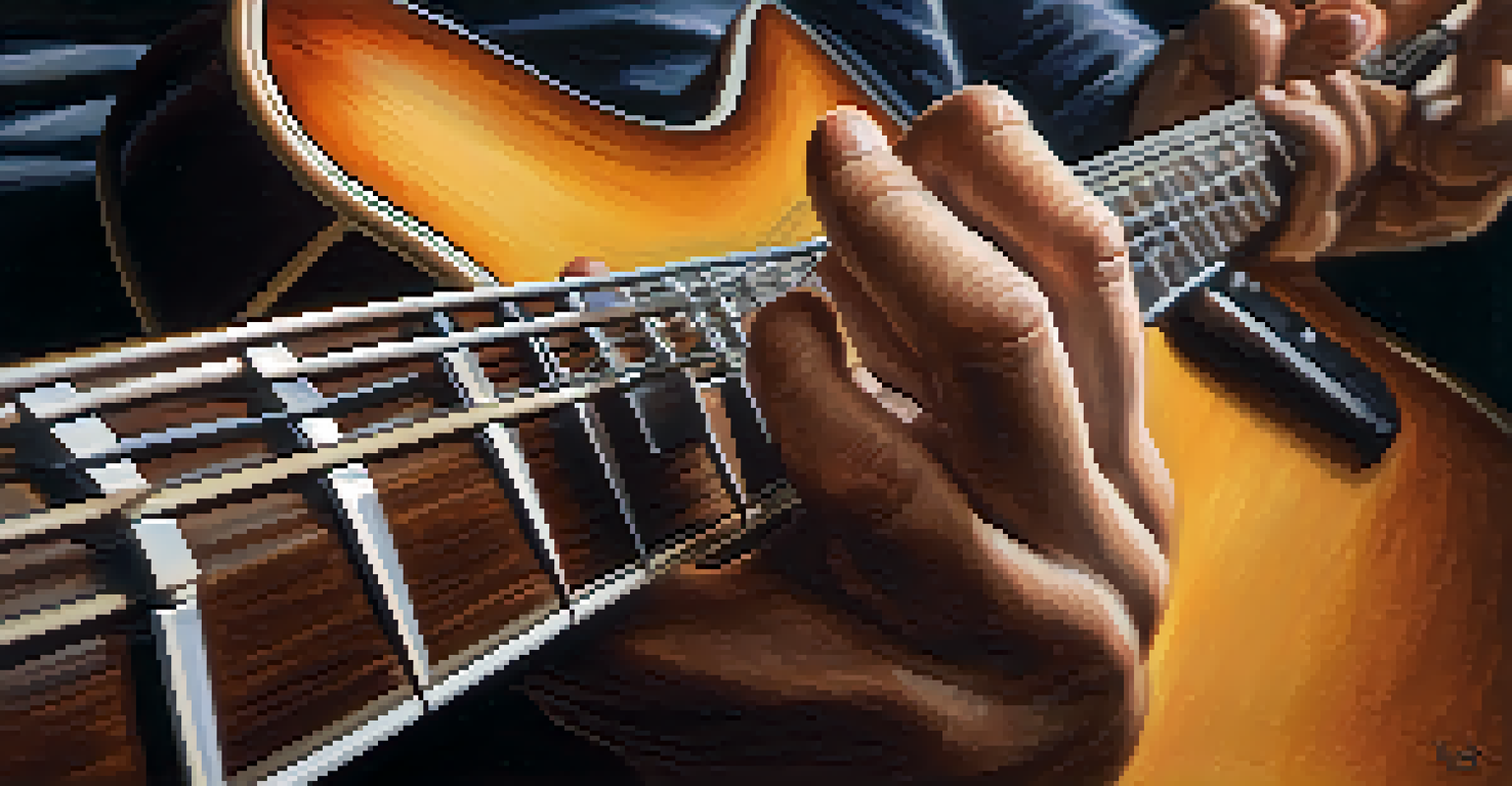Chord Progressions: Crafting Songs on Your Guitar

Understanding Chord Progressions: The Building Blocks of Music
Chord progressions are the backbone of any song, serving as the framework that supports melodies and lyrics. They consist of a series of chords played in sequence, creating a harmonic foundation. Just like a painter needs a canvas, a musician needs chord progressions to craft their masterpiece.
Music can change the world because it can change people.
Think of a chord progression as a musical journey. Each chord leads you somewhere, creating feelings and emotions that resonate with listeners. For example, a simple progression like C-G-Am-F evokes a sense of warmth and familiarity, often found in pop and rock songs.
Understanding chord progressions not only enhances your playing but also deepens your appreciation for the music you love. By recognizing these patterns, you can start to see how your favorite songs are structured, making it easier to create your own.
Common Chord Progressions: Your Go-To Patterns
There are several popular chord progressions that have stood the test of time, and learning them can jumpstart your songwriting. One of the most famous is the I-IV-V progression, often used in blues and rock music. For example, in the key of C, this would be C-F-G, a simple yet powerful sequence.

Another widely used progression is the I-V-vi-IV, which has become a staple in modern pop music. You can hear it in countless hits, making it a reliable choice for songwriters. In the key of C, it translates to C-G-Am-F, showcasing how versatile these patterns can be.
Chord Progressions Shape Emotion
The choice of chord progressions significantly influences the emotional impact of a song, guiding listeners through a range of feelings.
By mastering these common progressions, you’ll gain the confidence to experiment and even modify them to suit your style. The beauty of music lies in your creativity, and these foundational patterns are just the beginning of your journey.
Creating Emotional Impact: The Role of Chord Progressions
Chord progressions do more than just set the stage; they evoke emotions and tell a story. The choice of chords can shape how a listener feels, whether it’s joy, melancholy, or nostalgia. For instance, a minor chord progression often conveys sadness, while major chords tend to uplift.
Without music, life would be a mistake.
Take a moment to listen to your favorite songs and analyze their progressions. Notice how the shifts between major and minor chords create emotional dynamics. A classic example is in 'Someone Like You' by Adele, where the progression enhances the heartfelt lyrics, amplifying the song's emotional weight.
Understanding this emotional aspect allows you to craft songs that resonate deeply with your audience. By intentionally choosing progressions that match the feelings you want to convey, you can transform a simple melody into a powerful experience.
Experimenting with Variations: Adding Your Unique Touch
Once you're comfortable with common chord progressions, it’s time to get creative! Variations are a fantastic way to inject your personality into your music. You can change the order of chords, use different voicings, or even add extensions like seventh or ninth chords to enhance the harmony.
For example, instead of sticking strictly to a C-G-Am-F progression, try adding a Dm or an Em to create tension and release. This small change can drastically alter the feel of your song, making it uniquely yours. The key is to experiment and see what resonates with you.
Experiment for Unique Sound
Exploring variations in chord progressions allows songwriters to infuse their personal style and creativity into their music.
Don’t be afraid to break the rules! Some of the best songs come from unexpected chord combinations. Trust your instincts and let your creativity flow; music is meant to be explored and enjoyed.
How to Use Chord Progressions in Songwriting
When writing a song, start by selecting a chord progression that matches the theme or vibe you want to convey. This sets the tone and gives you a solid foundation to build upon. You might find that different progressions inspire different lyrical ideas or melodies.
Once you have your progression, play around with the rhythm and strumming patterns. This can bring a whole new dimension to your song. Try varying the tempo or using fingerpicking instead of strumming to see how it changes the feel of the music.
As you develop your song, don’t hesitate to tweak the progression as needed. Sometimes, a slight adjustment can lead to a breakthrough moment in your songwriting process. Keep an open mind and enjoy the journey of creating!
The Importance of Practice: Mastering Your Progressions
Like any skill, mastering chord progressions takes practice. Set aside time each day to work on your transitions between chords, focusing on smoothness and clarity. The more comfortable you become with switching chords, the easier it will be to experiment with songwriting.
Consider playing along with your favorite songs to internalize how different progressions work within the context of a full composition. This will not only improve your playing but also give you insights into song structure and arrangement.
Practice Enhances Skill Mastery
Regular practice of chord transitions is essential for mastering progressions, enabling smoother playing and more confident songwriting.
Remember, progress takes time, so be patient with yourself. Celebrate small victories, whether it's nailing a tricky transition or writing a new verse. Each step forward brings you closer to becoming the songwriter you aspire to be.
Inspiration from Great Songwriters: Learning from the Masters
One of the best ways to grow as a songwriter is to learn from those who have come before you. Listen to a wide variety of artists and pay attention to their chord progressions. Try to analyze what makes their songs so captivating and how they use progressions to evoke emotion.
Great songwriters often draw inspiration from different genres and styles, so don’t limit yourself. Explore everything from folk to jazz to pop, and see how these influences can inform your own songwriting. You might discover a unique blend that resonates with you.

Ultimately, every great songwriter started as a beginner, so don’t be afraid to make mistakes along the way. Embrace the learning process and allow yourself the freedom to grow and evolve as an artist.